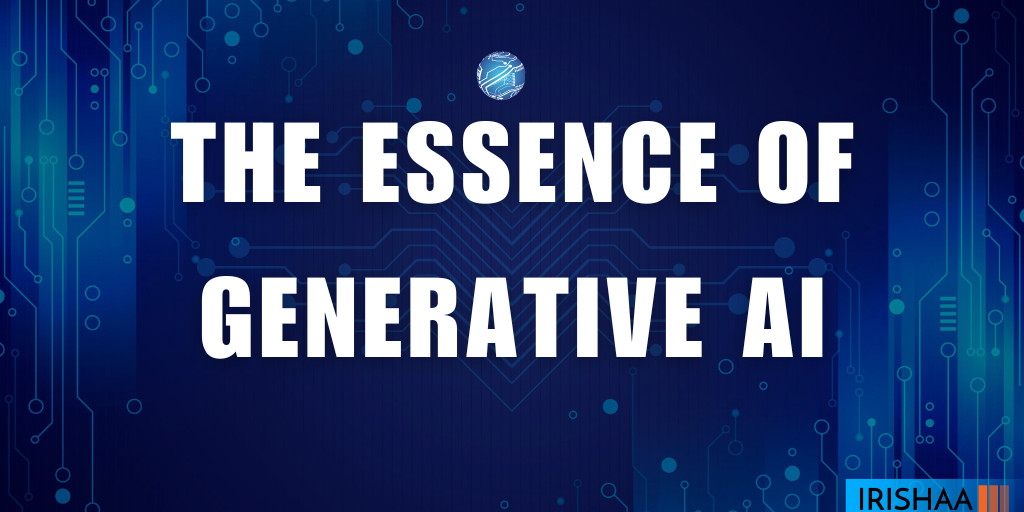The Essence of Generative AI: What It Is and Why It Matters

Table of Content:
Introduction
What is Generative AI?
How Does Generative AI Work?
Applications of Generative AI
The Future of Generative AI
Ethical Considerations
Conclusion
1. Introduction
Generative AI is a term that resonates with innovation, creativity, and future technology. But what exactly does it mean? How is it shaping our world, and why is it becoming increasingly vital in various sectors? In this comprehensive guide, we'll explore the intriguing concept of Generative AI, unmasking its nature, its functioning, and its growing significance in fields ranging from art to healthcare. Whether you're an AI enthusiast or someone keen to understand how Generative AI affects everyday life, this blog post will serve as your roadmap into this fascinating realm.
2. What is Generative AI?
Generative AI belongs to a subset of algorithms used in machine learning, focusing on generating new data that's similar to a given input. In other words, these algorithms create something new, whether it's an image, sound, or textual content, based on patterns they learn from existing data.
Generative AI represents a significant leap in the field of artificial intelligence, unlocking an array of possibilities that extend far beyond mere automation. It refers to a class of algorithms that are capable of creating new data instances that resemble a given set of data. From creating stunning pieces of art to predicting complex weather patterns, Generative AI serves as a catalyst for innovation across various domains. The application of these algorithms goes beyond novelty; they are transformative tools that can enhance efficiency, foster creativity, and pave the way for new discoveries. In a world driven by data and technology, understanding the applications of Generative AI is vital for anyone interested in the future of science, business, and society at large. In the sections that follow, we will delve into the numerous areas where Generative AI is making waves, changing paradigms, and providing solutions to some of today's most pressing challenges.
Understanding the Basics
Nature of Generation: Generative AI doesn't merely mimic or replicate existing data; it interprets patterns and produces something novel yet similar.
Versatility: It can be applied across various domains like images, text, speech, and more.
Building Blocks: Generative AI leverages complex algorithms, neural networks, and statistical tools to achieve its goals.
The beauty of Generative AI lies in its ability to learn and then create, turning abstract data into tangible results.
3. How Does Generative AI Work?
Generative AI operates on a fascinating combination of creativity and algorithmic precision. Here’s how:
1. Art and Design
Artistic Creation: Artists are using Generative AI to produce unique artworks, from paintings to sculptures.
Design Optimization: Generative AI can also assist in optimizing designs by rapidly iterating and exploring various design alternatives.
2. Healthcare and Biomedicine
Drug Discovery: Generative AI can generate molecular structures that may lead to new pharmaceuticals.
Medical Imaging: In diagnostics, it can aid in enhancing medical images or even generating synthetic data for training purposes.
3. Entertainment and Media
Video Games: Game developers are using Generative AI to create immersive environments, characters, and narratives.
Film Production: Filmmakers can use it for special effects, scene creation, and more.
4. Retail and E-commerce
Personalized Recommendations: E-commerce sites can use Generative AI to create personalized marketing materials based on user preferences.
Virtual Try-Ons: Customers can virtually try on clothes, glasses, or other wearables with the help of Generative AI.
5. Finance and Economics
Risk Management: Generative models can simulate various economic scenarios to assist in risk assessment and management.
Algorithmic Trading: Traders can use Generative AI to model market behaviors and develop trading strategies.
6. Manufacturing and Engineering
Product Development: Engineers are using Generative AI to design and optimize new products, from car parts to aerospace components.
Quality Control: It can also assist in identifying defects or inconsistencies in manufactured goods.
7. Education and Research
Educational Content Generation: Generative AI can create customized educational materials, catering to individual learning needs.
Scientific Simulation: In research, it can be used to simulate complex systems, enabling scientists to explore phenomena that might be difficult to study directly.
8. Climate and Environmental Science
Climate Modeling: Environmental scientists are using Generative AI to model complex climate patterns.
Resource Optimization: It can also aid in optimizing resource usage in various industrial processes, contributing to sustainability.
4. Applications of Generative AI
1. Media and Journalism
Automated Content Creation: Generative AI can write news articles or reports based on data inputs, saving time and resources.
Personalized Content Delivery: It can curate personalized news feeds for readers based on their interests and reading habits.
2. Agriculture and Food Industry
Crop Modeling: By simulating various environmental conditions, Generative AI can help farmers predict crop yields and optimize farming practices.
Food Design: It can be used to create new recipes and food products tailored to specific nutritional needs or preferences.
3. Real Estate and Urban Planning
Virtual Tours: Generative AI can create realistic virtual tours of properties, aiding in real estate marketing.
Urban Design Optimization: City planners can utilize Generative AI to model and optimize urban layouts, improving efficiency and sustainability.
4. Automotive Industry
Vehicle Design: Automotive designers are using Generative AI to explore new vehicle designs and optimize existing ones.
Traffic Simulation: Generative models can simulate complex traffic patterns, assisting in transportation planning and autonomous vehicle development.
5. Music and Sound Production
Music Composition: Composers and musicians can use Generative AI to create new compositions or enhance existing pieces.
Sound Effects Generation: Sound designers can use it to generate unique sound effects for films, games, and other media.
6. Human Resources and Recruitment
Resume Screening: HR professionals can utilize Generative AI to create personalized responses to applicants, enhancing the recruitment process.
Workforce Modeling: It can assist in modeling and predicting workforce trends, helping organizations plan and optimize their human resources.
7. Tourism and Hospitality
Travel Planning: Generative AI can help travelers create personalized travel itineraries based on their preferences.
Customer Service Automation: Hotels and restaurants can use Generative AI to respond to customer queries and requests, enhancing the customer experience.
8. Legal and Compliance
Legal Document Generation: Lawyers and legal professionals can use Generative AI to draft legal documents based on specific inputs.
Compliance Monitoring: It can also aid in monitoring and ensuring compliance with various regulations and standards.
5. The Future of Generative AI
Generative AI is poised to become one of the most influential technological advancements of the 21st century. Its potential to create, innovate, and transform is nearly boundless. Let's delve deeper into what the future could potentially bring:
More Advanced Models and Techniques
Refinement of Algorithms: As research continues, algorithms like Generative Adversarial Networks (GANs) and Variational Autoencoders (VAEs) will become more refined, allowing for more precise and versatile creations.
Real-time Generation: Future advancements may lead to real-time generative processes, enabling immediate applications in various fields such as interactive design or live performances.
Wider Adoption Across Industries
Mainstream Acceptance: As understanding and trust in Generative AI grow, it will likely become a standard tool across industries, from entertainment to healthcare.
Custom Solutions: Businesses will increasingly leverage Generative AI to provide personalized solutions to clients, enhancing customer experience and engagement.
Integration with Other Emerging Technologies
Combination with AR/VR: Generative AI could be integrated with augmented and virtual reality to create immersive and dynamic experiences.
IoT Integration: Coupling Generative AI with the Internet of Things (IoT) could lead to intelligent automation and personalized interfaces within smart homes and cities.
Educational and Research Prospects
Educational Tools: Generative AI can be harnessed to create customized learning materials and tools, enhancing education across all levels.
Accelerating Research: In fields such as biology, physics, and medicine, Generative AI can model complex systems, speeding up research and discovery.
Ethical and Regulatory Development
Regulatory Frameworks: The future will likely see the development of global standards and regulations that govern the use of Generative AI, ensuring its ethical application.
Transparency and Explainability: Efforts to make Generative AI more transparent and understandable will be vital for its responsible use and public acceptance.
Environmental and Societal Impact
Sustainability: Generative AI can contribute to sustainability efforts by optimizing resource use, modeling ecological systems, and developing innovative solutions to environmental challenges.
Cultural Impact: The way we perceive creativity and innovation might change, as Generative AI blurs the lines between human and machine-generated content, leading to new forms of collaboration and expression.
6. Ethical Considerations in Generative AI
Generative AI presents a host of ethical challenges and opportunities that must be addressed to ensure responsible development and deployment. Let's highlight some crucial areas to consider:
Data Privacy and Security
Sensitive Information: Generative AI models often require vast amounts of data. Making sure the confidentiality and security of sensitive data is of the utmost importance.
Consent and Ownership: Understanding where the data comes from and obtaining proper consent for its use is vital to ethical practice.
Authenticity and Misuse
Deepfakes and Misinformation: Generative AI's ability to create highly realistic content can be misused for creating deepfakes, leading to misinformation and fraud.
Verification Tools: The development of tools to authenticate content generated by AI is becoming increasingly necessary to maintain trust and integrity in digital communication.
Bias and Fairness
Training Data Bias: If biases are present in the training data, Generative AI models can inadvertently perpetuate or even exacerbate these biases.
Inclusivity and Diversity: Ensuring that AI models are trained on diverse and representative data sets is crucial to prevent unintentional discrimination and ensure fairness.
Economic and Labor Considerations
Job Displacement: Automation through Generative AI may lead to job displacement in certain industries. Thoughtful implementation and workforce retraining can help mitigate these effects.
Economic Accessibility: Ensuring that the benefits of Generative AI are accessible across different socio-economic strata is vital for equitable development.
Environmental Impact
Resource Consumption: Training complex Generative AI models requires substantial computational resources, which can have significant energy and environmental impacts.
Sustainable Practices: Developing energy-efficient algorithms and using renewable energy sources can contribute to more sustainable AI practices.
Transparency and Accountability
Explainability: Generative AI models can be complex and opaque. Efforts to increase transparency and explainability are essential for building trust and ensuring responsible use.
Regulation and Oversight: Developing clear regulations, standards, and oversight mechanisms will be key to ensuring that Generative AI is used ethically and responsibly.
7. Conclusion
The essence of Generative AI lies in its extraordinary ability to create, innovate, and transform various aspects of human life. From aiding in scientific discoveries to reshaping artistic creation, Generative AI is not just a technological marvel but a glimpse into the future of human-machine collaboration.
With its growing applications, Generative AI also brings with it the responsibility to handle ethical considerations prudently. Balancing innovation with integrity is key to leveraging the full potential of this remarkable technology.
In a world where creativity is celebrated, and innovation is pursued relentlessly, Generative AI stands as a testament to human ingenuity, making complex creations accessible and augmenting human abilities like never before.
Ethics in Generative AI is a multifaceted and evolving area that requires ongoing attention, reflection, and action. As we continue to explore and exploit the creative potential of these technologies, we must also develop robust ethical frameworks that align with societal values and norms.
The future success and social acceptance of Generative AI depend not only on technological innovation but also on our collective ability to navigate these ethical considerations with wisdom, empathy, and foresight.
The conversation around ethics in Generative AI is far from over, and it will continue to shape and be shaped by technological advancements, regulatory decisions, public discourse, and individual choices.
As we continue to explore and harness the power of Generative AI, it will undoubtedly emerge as a transformative force, catalyzing new ways of thinking, working, and living.


